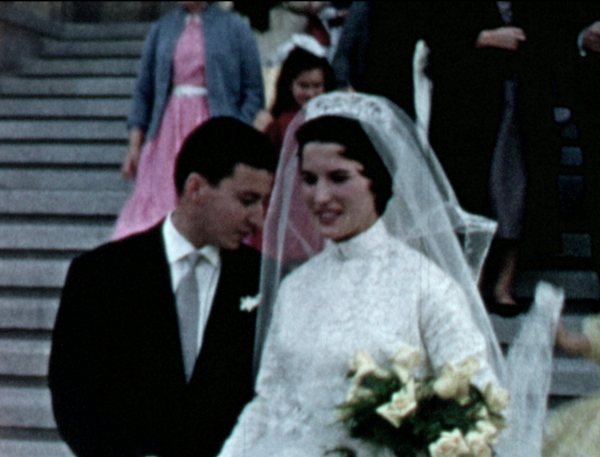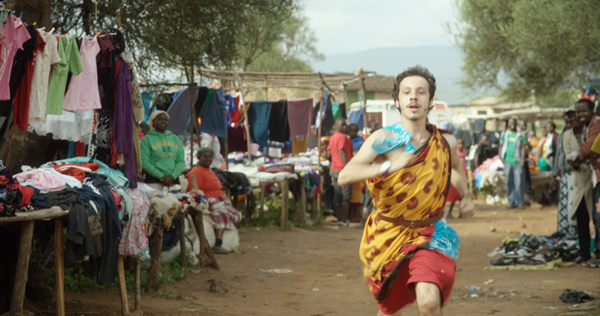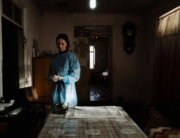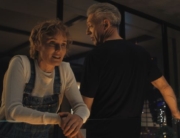To make the most of what the Cannes Film Festival has to offer, the best course of action is to sample as much as possible from all of the programming selections. To watch just those in the competition would be to deprive yourself of first-time or unfamiliar filmmakers. Similarly, relying solely on the films that were up for the Palme d’Or would actually have been dispiriting, especially this year. Though some of the world’s most acclaimed and well-known directors were competing for the festival’s top prize (such as Michael Haneke), they provided few works that stood out.
But there were surprises screening elsewhere. The movies below were shown away from the throngs of photographers and the red carpet. I knew nothing or very little about these movies before entering the theater, which is generally how I like to approach all films at the festival, to the extent that’s possible. The result: You win some, you lose some. Here are some winners:
Carré 35 (Plot 35)
![]() French actor Éric Caravaca makes his documentary directorial debut in this frank, intriguing memoir that probes his family’s history of denial. He unlocks one unsettling secret after another in a work that fluidly weaves the past with the present. Without any strain, he ties the family’s biography to a larger picture, the French post-colonial diaspora after the Algerian War of Independence.
French actor Éric Caravaca makes his documentary directorial debut in this frank, intriguing memoir that probes his family’s history of denial. He unlocks one unsettling secret after another in a work that fluidly weaves the past with the present. Without any strain, he ties the family’s biography to a larger picture, the French post-colonial diaspora after the Algerian War of Independence.
The first mystery he confronts in, as he describes it, “a culture of oblivion” is, what happened to his parents’ first child, Christine, who died at age three in Algeria before the director was born? According to his mother, her first-born’s heart gave up. The title refers to the sister’s cemetery plot, which has been maintained by a stranger, unbeknownst to the family—just one of the film’s many revelations.
What puzzles Caravaca more is why his mother burned all photos of his sister and hardly ever mentioned her daughter. And that’s not the only ambiguous family matter. Stories change, depending on which relative is telling them; even Christine’s age at her death becomes a matter of debate.
Caravaca combines a personal form of investigative journalism with atmospheric sequences of his parents’ former North African homeland, seamlessly woven with family home movies and photos. At 67 minutes, it’s the most succinct film at the festival, and one of the most empathetic. Even though Cannes programs a small selection of nonfiction films, the four I saw (including Faces Places, Napalm, and Becoming Cary Grant) were stronger overall than the feature films, whether in competition or elsewhere. (Carré 35 is dedicated to the late François Dupeyron, who directed Caravaca in 2001’s The Officer’s Ward.)
Gabriel and the Mountain
Playing in the Critics’ Week sidebar, this vibrant and inherently compassionate film deserved to win the top two awards for that section, the Visionary Prize and the Fondation Gan Award.
The film is centered on, and dedicated to, Gabriel Buchmann, a friend and classmate of Brazilian director Fellipe Gamarano Barbosa. Buchmann perished in 2009 while taking a self-imposed gap year worldwide, and it’s giving nothing away to say that in the opening sequence, two men find Gabriel’s body on the slopes of Malawi’s Mount Mulanje, the trees having camouflaged his body from the search helicopters.
The first chapter (“Kenya”) begins 70 days before that discovery. Ostensibly, Gabriel backpacks country-to-country alone to research poverty. He’s at a crossroads, rejected by Harvard but with an option to go to UCLA. Some of the real-life individuals who encountered the young Brazilian traveler play themselves, reenacting their interactions or offering testimonials for director Barbosa’s camera. These moments are improvised, like much of the film.
Living with a Maasai family, Gabriel dresses in the traditional shuka and attempts to learn their language. He’s frequently referred to as “mzungu,” meaning white man, which as a Brazilian, though white, he begs to differ. Like many international travelers, he wants to have it both ways: to be part of and blend into his foreign surroundings, yet he can’t completely let go and shed his past—in this case a privileged, upper-middle class upbringing.
On his long climb up Mount Kilimanjaro, he loses patience and wants to turn back, but is dissuaded. Unprepared for the cold nighttime weather in the high elevation, he wakes up his guide (again, played by the man who actually led Gabriel), demanding that they resume their ascent in the dark, early-morning hours—and yes, the film takes viewers to the highest point on the continent. He grimaces at the regional music playing on a local radio station, patronizingly calls one guide “lazy,” and is on the defensive, either feeling ripped-off or on high alert for dishonesty, no matter if he offends.
Whether idealistic or entitled, Gabriel has charm to spare thanks to a wide-eyed, up-for-anything performance by actor João Pedro Zappa. The film unfolds, not hurried or slow, with a sleight directorial touch, and steadily becomes engrossing. There were many other Cannes offerings that were filmed in a similar fashion of handheld, long takes. Gabriel proves how effectively this style of filmmaking can be when you have strong actors and a script that continuously peels off more layers from the characters. Besides a portrait of contradictions, the movie also doubles as a wonderful piece of armchair traveling.
Oh Lucy!
This fresh, dark bilingual comedy by Atsuko Hirayanagi, making her feature debut, is not what most would expect from executive producers Will Ferrell and Adam McKay. Not to be snobby, but this somber art house drama-meets-twisted romcom is not like their other collaborations. After all, it begins with the lead character, Setsuko, witnessing a man throwing himself before an approaching subway train.
Chain smoker Setsuko (Shinobu Terajima) joins a singular movie sorority, that of the quietly ferocious middle-aged, single woman, who would have been referred to not so long ago as a spinster or old maid. Among the old-school members of this club are The Heiress’s Olivia de Havilland and Rosalind Russell’s embittered single schoolteacher in Picnic. Though those two examples were stymied by social conventions, Setsuko defies them by taking burning-down-the-house action. She has options, and she seizes them. In its anarchic spirit, Oh Lucy! is a cousin to Muriel’s Wedding.
Somewhere in her 40s, Setsuko wears a gray sweater over a gray overcoat and works in a low-rent, fishbowl office. She’s more than twice the age of other women in the office, and her closest contemporary is about to retire; after 42 years of service, the coworker receives flowers and a giant teddy bear.
In a quirky plot development straight out of an early ’00 indie, she agrees to take over the tuition for English classes from her vivacious, barely-out-of-her-teens niece, Mika (Shioli Kutsuna). The class oddly takes place in a room at a brothel (quirk alert) and is taught by the clean-cut—well, at first glance—and bespectacled John Woodruff, a role that’s a change of pace for Josh Hartnett.
John’s lessons are more about attitude than linguistics. As long as she’s in class, she will be called Lucy, he says, as he plops a curly blonde wing over her tightly-permed reddish hair: “Lucy is a very relaxed girl.” His methodology, if that’s what you call it, is to get her to relax the American way, with a hug. Once Setsuko/Lucy gets the hang of it, she holds on to him for dear life.
She admits to her niece that it’s a very strange school, but she returns for her next lesson. However, she finds John missing in action; he has gone back to America. Second bombshell: He has taken Mika with him, causing Setsuko to make a sudden vacation request; she’s off to find Mika and John, and not necessarily in that order.
Hartnett’s role is that of a heartthrob, at least to Setsuko and Mika. He’s a layabout, vacuous intruder to Mika’s mother/Setsuko’s sister, Ayako (Kaho Minami)—she actually has his number, more so than the other two women. Ayako, too, joins Setsuko on the international flight to California, and with their long history of mutual resentment, the siblings are perfectly content to sit a seat apart. (There’s a too-short appearance by Megan Mullally as the American in the middle.)
The film crams a lot of character development and story into 95 minutes; the point-to-point transitions are often bumpy. Yet it credibly captures a slice of Southern California life that rarely appears onscreen: the roadside hotels; the pale, hazy white light; the aging fast-food strip malls. Only the coastline receives a glamorous close-up.
With the help of her alter-ego Lucy, Setsuko does, indeed, get her groove on during her impulsive travels, which turn out to be spectacularly messy. However, her rising self-esteem comes with a shocker of a twist. Revenge is served with gleeful laughter.









Leave A Comment